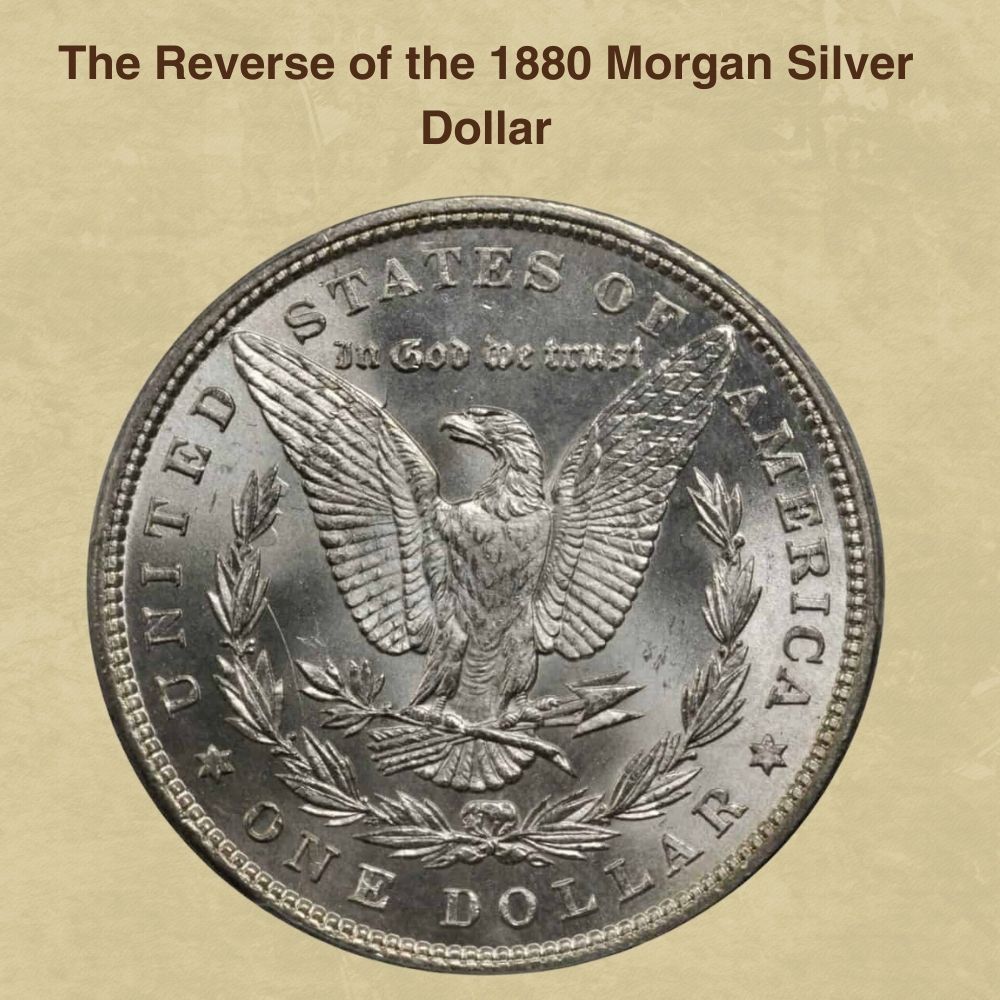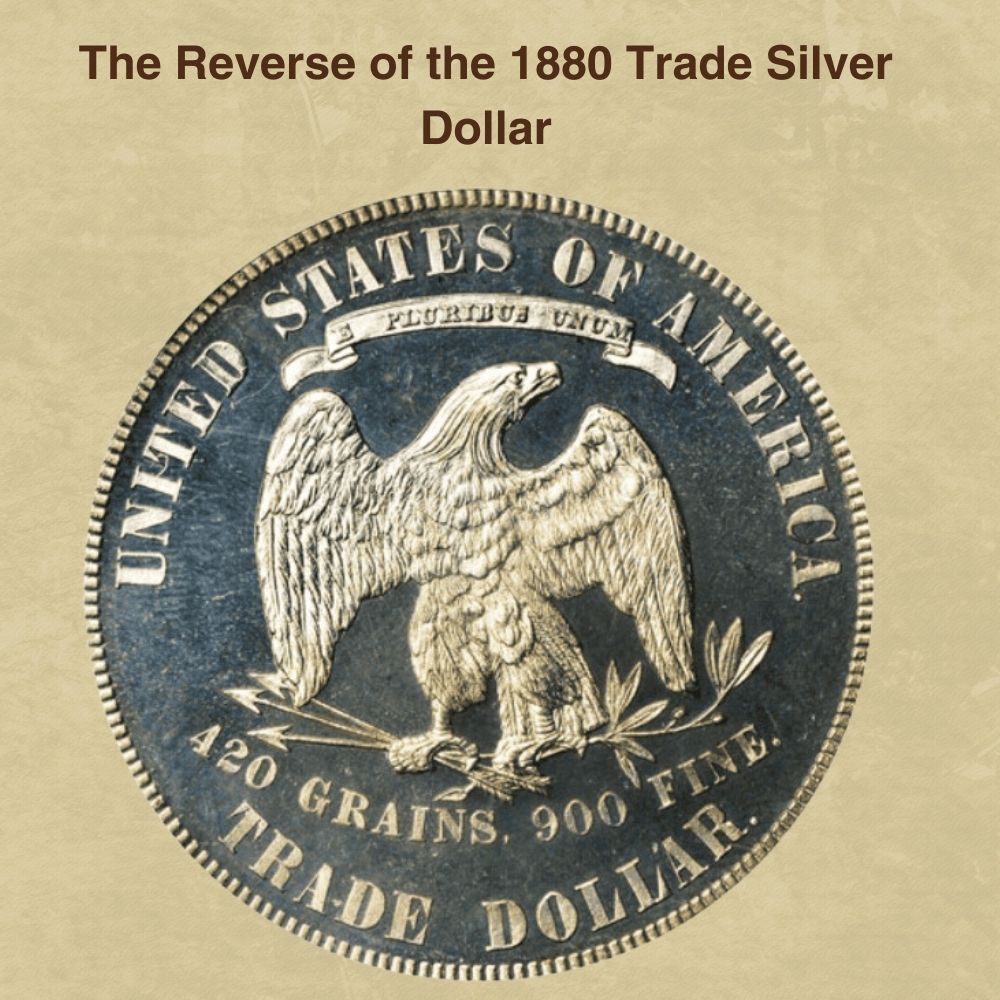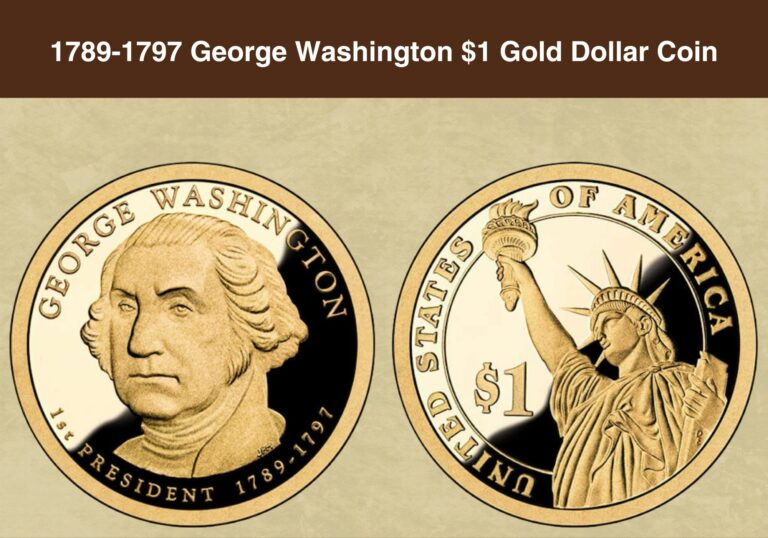
Coin Value Contents Table
- History of the 1880 Silver Dollar
- Features of the 1880 Silver Dollar
- 1880 Silver Dollar Grading
- 1880 One Dollar Coin Value Guides
- 1880 No Mint Mark Morgan Silver Dollar Value
- 1880-O Morgan Silver Dollar Value
- 1880-S Morgan Silver Dollar Value
- 1880-CC Morgan Silver Dollar Value
- 1880 (P) Proof No Mint Mark Morgan Silver Dollar Value
- 1880 (P) Proof No Mint Mark Trade Silver Dollar Value
- Rare 1880 Silver Dollar Error List
- Where to Sell Your 1880 Silver dollar ?
- 1880 Silver Dollar FAQs
As an ordinary consumer, you’re probably not interested in $1 coins. They’re too bulky for your purse or pockets, and quarters are way more convenient. But as an investor or reseller, these coins are pure gold, pun intended. And the older the better! So let’s explore the 1880 Silver Dollar value. We’ll learn more about its history, record prices, and current evaluations.
1880 Silver Dollar Value Chart |
||||||
| Coin | Very Fine VF 35 | Extremely Fine EF/XF 45 | About Uncirculated AU 55 | Low Mint State MS 61 | High Mint State MS 66 | Proof PR 68 DCAM |
| 1880-O Silver Morgan Dollar | $44 | $60 | $90 | $200 | $200,000 | – |
| 1880-S Silver Morgan Dollar | $44 | $48 | $62 | $78 | $425 | – |
| 1880-CC Silver Morgan Dollar | $415 | $455 | $550 | $725 | $3,150 | – |
| 1880 (P) No Mint Mark Silver Morgan Dollar | $44 | $48 | $62 | $85 | $2,000 | – |
| 1880 (P) No Mint Mark Proof Morgan Dollar | – | – | – | – | – | $52,500 |
| 1880 (P) No Mint Mark Proof Trade Dollar T$1 | – | – | – | – | – | $140,000 |
History of the 1880 Silver Dollar
In the early years, lots of $1 coins were exported, melted, and re-imported as silver bullion. This was because American $1 coins had less fine silver than competing currencies so they were perfect for profiteering. But in the late 1800s, the US needed to compete with foreign coins in Asia, so they introduced the Silver Trade Dollar with significantly more silver in it.
Locally though, the Morgan Silver Dollar was used. Since people rarely used $1 coins in their daily transactions, these coins largely languished in vaults as securities for Silver Certificates. For the record, these certificates served as the first $1 Bills, and they helped established the stubborn US preference for $1 notes over $1 coins. This unbreakable habit persists to date.
But let’s get back to Silver Dollar coins. The Trade Dollar was designed by the 5th Chief Mint Engraver, William Barber. Meanwhile, the Morgan Dollar came from an assistant, George T. Morgan. He had been shipped over from England to work on the coin thanks to a request by the Mint Director, Henry Linderman. His contract was six months, but he stayed a lot longer.
Morgan eventually became the 7th Mint Engraver, taking over from Charles Barber when he died. Charles was William’s son, and both he and Morgan trained under Barber Senior as his assistants. Before Morgan, mint workers never attributed their work to themselves. He was the first one to sign his coins with his initial, M, later followed by the B for Charles Barber.
Also read: 12 Most Valuable One-Dollar Coin Worth Money
Features of the 1880 Silver Dollar
In discussing the features of both 1880 Silver Dollars, we’ll use some jargon, so let’s go over the key technical terms. The front or heads side of a coin is its obverse while the back or tails side is its reverse. The thinnest sides are called its edges and the raised border is the collar or rim. The images are devices, the words are mottos/legends, and the background is the field.
The Obverse of the 1880 Morgan Silver Dollar
It shows Anna Willess Williams posing as Lady Liberty. She’s facing left, with a Phrygian cap, sprigs of maple and wheat in her hair, and a headband that says Liberty. The top of the coin says E Pluribus with 7 stars on the left and 6 stars on the right. The mint date sits between the two sets of stars. Lady Liberty’s neckline has M for Morgan near her lowest lock of hair.
The Reverse of the 1880 Morgan Silver Dollar
It shows an eagle with its wings spread out and pointing upward. The motto In God We Trust is between the wings. The eagle holds three arrows and an olive branch. An olive wreath curls under the wings tied with a ribbon. There’s a tiny M for Morgan the designer on its left loop.
Below is the denomination, One Dollar. On coins from San Francisco, Carson City, and New Orleans, the mint mark sits above the D and the O in Dollar, under the knot on the ribbon. The top of the coin has the legend United States of America, with stars flanking the phrase.
Other Features of the 1880 Morgan Silver Dollar
The Morgan Dollar was 90% Silver and 10% Copper. But since it was only used locally, it had 412.5 grains of fine silver – slightly less than the Trade Dollar. This made it lighter at 26.73g. The silver dollar was 38.1mm in diameter (1.5”) and 2.4mm thick (0.09”) with a reeded edge.
The Obverse of the 1880 Trade Silver Dollar
It shows Lady Liberty pointing an olive branch toward the ocean. She’s sitting on bales of cargo with sheaves of wheat stacked behind her. She has a ribbon tagged Liberty. A plaque beneath her reads In God We Trust. The coin has 13 stars on top and the mint date below.
The Reverse of the 1880 Trade Silver Dollar
The eagle has its wings spread but pointing down, with three arrows and an olive branch in its talons. The top reads United States of America. Under that is a ribbon with E Pluribus Unum. The bottom has Trade Dollar. Above that is the silver content: 420 Grains, 900 Fine.
Other Features of the 1880 Trade Silver Dollar
Like the Morgan Dollar, it was 90% Silver and 10% copper. But it had more silver in it – 420 grains – so it weighed 27.2g. But its dimensions were the same – 38.1mm across (1.5”) and 2.4mm thick (0.09”). It had the same reeded edge, but the arrows and branch were opposite.
Also read: 14 Most Valuable Coins In Circulation
1880 Silver Dollar Grading
Morgan Dollars are quite old, so these antique coins have a few extra grades. As we said before, beyond the usual range of Poor 1 (PO 1) to Mint State 70 (MS 70), you can find coins rated PL (Proof-Like) i.e. circulating coins that are highly reflective. You’ll also see DMPL or Deep-Mirror-Proof-Like coins. They look like DCAMs made from unburnished planchets.
| # | Grade |
|---|---|
| 1 | Basal State-1 |
| 2 | Fair |
| 3 | Very Fair |
| 4, 5, 6 | Good |
| 7, 8, 10 | Very Good |
| 12, 15 | Fine |
| 20, 30 | Very Fine |
| 40 | Extremely Fine |
| 50 | About Uncirculated |
| 60 | Mint State |
| 65 | Mint State |
| 70 | Mint State |
Please check our grading guides to know your coin scale, It’s the necessary step to know the exact value of your coin.
Check out now: How to Grade Morgan Silver Dollar?
1880 One Dollar Coin Value Guides
Usually, the US Mint made Silver Dollars in two styles – Morgan Dollars for local use and Trade Dollars for overseas transactions, mostly in Asia. 1880 Trade Dollars were strictly for collectors so they only made proofs in Philadelphia. But 1880 Morgan Dollars were coined in New Orleans, Philadelphia, Carson City, and San Francisco – both proofs and regular strikes.
1880 No Mint Mark Morgan Silver Dollar Value
In 1880, the Philadelphia Mint made 12.6M Morgan Dollars including proofs. The current sales record is $27,917 for an MS 67, and it was set on 12th August 2006. But some circulating 1880 Silver Dollars can pass for proofs. Such coins are rated PL (Proof-like) or DMPL (Deep-Mirror-Proof-Like). An MS 66 DMPL was $31,200 on 24th January 2021. Three are known.
1880-O Morgan Silver Dollar Value
The Morgan Dollar was coined from 1878 to 1904. In 1880, they minted 5,305,000 at the New Orleans Mint with the O Mint Mark. An MS 65+ sold for $41,125 on 8th January 2014. The highest known grade, MS 66, is estimated at $200,000 with three pieces known. But an MS 65 PL went for $31,050 in November 2004 while an MS 65 DMPL was $54,625 in 2009.
1880-S Morgan Silver Dollar Value
San Francisco didn’t switch to collectible exclusivity until 1975 so back in 1880, they minted 8.9M Silver Morgan Dollars. Even then, their quality was prized. An MS 69 was $162,000 in January 2021 and is now worth $165,000. An MS 69 PL sold somewhat lower at $99,875 in January 2017. But the record for MS 68 DMPL is a third of that at $33, 350 in January 2005.
1880-CC Morgan Silver Dollar Value
The Carson City Mint had the lowest mintage of Silver Morgan Dollars at 591,000. Ironically, they had the highest number of mint error varieties! But let’s start with flawless coins. An MS 67 was $47,000 in August 2012. Meanwhile, an MS 67 PL was $67,563 in June 2015. An MS 66 DMPL was $20,400 in August 2022. The highest grade, MS 68 is worth $300,000 today.
1880 (P) Proof No Mint Mark Morgan Silver Dollar Value
Mirror-like proof blanks aka planchets were burnished in a vat of stainless steel beads before striking to give them some extra shine. The die is specially treated as well. Some portions are pickled in acid to give the device a hazy frost. This fades every time the die hits a coin, so the first 50 to 100 had the strongest contrast between the mirror-like field and its frosted device.
These coins were graded Deep Cameo. The next 100 or so coins got the Cameo rating and the rest were standard proof coins. This continued until 1971. That’s the year when the US Mint started making proofs with digitized systems and laser frosting tools. In 1880, Philadelphia only made 1,355 Proof Morgan Dollars. One PR 69 sold for $70,150 on 9th January 2005.
Half a step below, a PR 68+ sold for $42,000 in January 2023. But with only one coin known it appreciated to $57,500 by April. Meanwhile, the record for a PR 68 CAM was $42,500 on 24th April 2022. Ten of them have popped up so far. But that’s not the highest grade. PCGS has received one coin rated PR 69 CAM and they assess its value as $110,000 in April 2024.
1880 (P) Proof No Mint Mark Trade Silver Dollar Value
The Silver Trade Morgan Dollar was coined from 1873 to 1885, but in 1880, they only made Proof Trade Dollars, since circulating Trade Dollars were demonetized in 1876. The mintage volume was low – just 1,987 coined as mirror-like proofs. Silver Trade Dollars were mostly used in Asia where merchants made chop marks to authenticate them. But proofs rarely do.
On 20th March 2003, a PR 67 Silver Trade Dollar sold for $32,200. The 2024 evaluation for a PR 67+ is $40,000. Only two samples are known. Meanwhile, a PR 68 CAM was $43,700 on 15th March 2004. It’s the highest known grade, currently evaluated at $120,000. As for Deep Cameos, a PR 68 DCAM was $74,750 on 29th November 2006 and is worth $140,000 today.
Also read: Top 10 Most Valuable Morgan Silver Dollar Worth Money
Rare 1880 Silver Dollar Error List
The method of making coins hasn’t changed much from the 1800s to today, but many of the steps are now mechanized or digitized. Although this reduces most coin flaws, some mint mistakes are still possible. For instance, a coin obverse may still be paired with the reverse of a different year. 1880 Silver Dollars have two such errors. Let’s glance at the resulting values.
1880 (P) Obverse with an 1879 Reverse – 1880/79 Overdate
This overdate error occurred at all four mint branches. The mistake is on the second 8, where the 7 from 79 was struck under the 8 from 80. In MS 66, this error was $14,950 in January 2011. PCGS has only received one thus far and estimates its value in July 2023 as $15,000.
1880-CC Overdate Obverse with 1878 Reverse
This overdate only happened at the Carson City branch. It’s similar to the error above, with the 7 from 78 below the second 8 in 80. But you can tell it’s a different year by checking the reverse feathers. An MS 66+ was $10,575 in 2013. An MS 65 DMPL was $17,250 in 2005.
1880-CC Obverse with 1879 over High 7 Reverse – 1880/79 High 7 Overdate
For this mint error, some coins had a High 7 while others had a Low 7 and that affects their resale price. On 5th March 2019, an MS 67+ with a High 7 sold for $52,800. Half a step down an MS 66 with a High 7 went for $37,375 on 22nd September 2010. Its 2023 value is $51,500.
1880-CC Obverse with 1879 over Low 7 Reverse – 1880/79 Low 7 Overdate
For comparison, an overdate with a Low 7 graded MS 67 sold for $24,000 on 30th November 2021. In July 2023, PCGS estimates its value as $35,000 since they’ve only received one for grading. Dropping half a step, one MS 66+ DMPL went for $12,000 in September of 2019.
Where to Sell Your 1880 Silver dollar ?
Now that you know the value of your coins, do you know where to sell those coins online easily? Don’t worry, I’ve compiled a list of these sites, including their introduction, pros, and cons.
Check out now: Best Places To Sell Coins Online (Pros & Cons)
1880 Silver Dollar FAQs
What Makes an 1880 Silver Dollar Valuable?
Multiple reasons. All varieties are silver, so the melt value is based on the spot price of this precious metal. Also, the coin is almost 150 years old, and older coins are intrinsically more valuable. Silver Trade Dollars and Morgan Dollars from 1880 can both fetch a decent price.




















I have 1880 Morgan coin dollar but it’s not a one dollar it’s 10.D